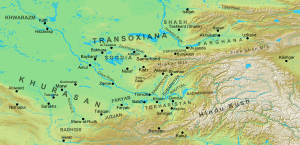Battle of the Pass
| Battle of the Defile | |||||||
|---|---|---|---|---|---|---|---|
| Part of the Umayyad-Turgesh Wars and the Muslim conquest of Transoxiana | |||||||
 Map of Transoxiana in the 8th century |
|||||||
|
|||||||
| Belligerents | |||||||
| Umayyad Caliphate | Turgesh Khaganate and Transoxianian allies | ||||||
| Commanders and leaders | |||||||
|
Junayd ibn Abd al-Rahman al-Murri Sawra ibn al-Hurr al-Abani |
Suluk | ||||||
| Strength | |||||||
| over 40,000 | unknown | ||||||
| Casualties and losses | |||||||
| 20,000 (Ibn A'tham), 25,000–30,000 (Blankinship) |
10,000 (Ibn A'tham) | ||||||
The Battle of the Defile or Battle of the Pass (Arabic: وقعة الشعب Waqʿat al-Shʿib) was fought in the Tashtakaracha Pass (in modern Uzbekistan) between a large Arab army of the Umayyad Caliphate and the Turkic Turgesh khaganate over three days in July 731 CE. The Turgesh had been besieging Samarkand, and its commander, Sawra ibn al-Hurr al-Abani, sent a request for relief to the newly appointed governor of Khurasan, Junayd ibn Abd al-Rahman al-Murri. Junayd's army was attacked by the Turgesh in the pass, and although the Umayyad army managed to extricate itself from the pass and reach Samarkand, it suffered enormous casualties (some 25,000–30,000 men), while Sawra's 12,000 men, who had been commanded to attack the Turgesh in the rear in a relief effort, were almost annihilated. The battle, for which one of the most detailed accounts of the entire Umayyad era survives in the History of al-Tabari, halted and even reversed Muslim expansion into Central Asia for a decade.
The region of Transoxiana (Arabic: Ma wara' al-nahr) had been conquered by the Muslims under Qutayba ibn Muslim in the reign of al-Walid I (r. 705–715), following the Muslim conquest of Persia and of Khurasan in the mid-7th century. The loyalties of its native Iranian and Turkic inhabitants and autonomous local rulers however remained volatile, and in 719, they sent a petition to the Chinese and their Turgesh vassals for military aid against the Muslims. In response, Turgesh attacks began in 720, and the native Sogdians launched uprisings against the Caliphate. These were suppressed with great brutality by the governor of Khurasan, Sa'id ibn Amr al-Harashi, but in 724 his successor, Muslim ibn Sa'id al-Kilabi, suffered a major disaster (the so-called "Day of Thirst") while trying to capture Ferghana. For the next few years, Umayyad forces were limited to the defensive. Efforts to placate and win the support of the local population by abolishing taxation of the native converts to Islam (mawali) were undertaken, but these were half-hearted and soon reversed, while heavy-handed Arab actions further alienated the local elites. In 728 a large-scale uprising, coupled with a Turgesh invasion, led to the abandonment of most of Transoxiana except for the region around Samarkand by the Caliphate's forces.
...
Wikipedia
